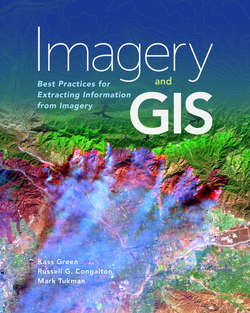Читать книгу Imagery and GIS - Kass Green - Страница 9
На сайте Литреса книга снята с продажи.
Book Organization
ОглавлениеThe organization of the book follows the organization of a typical imagery project workflow and is broken into four sections. The first section, Discovering Imagery—four chapters—provides the information needed to choose the best imagery to meet your needs. Chapter 2 introduces the structure of imagery data and presents a construct for thinking about imagery that is the foundation of this book, and also provides a decision framework for all of your work with imagery. Chapter 3 examines the fundamental collection and organizational characteristics of imagery that determine what imagery dataset will bring the most value to your projects. Chapter 4 provides a framework for choosing the best imagery to meet your needs and describes the variety of imagery datasets available.
The second section, Using Imagery in a GIS—two chapters—focuses on how to manipulate imagery to increase its value within a GIS. Chapter 5 discusses imagery storage and formats, displays, mosaicking, and accessing imagery as web services. Chapter 6 reviews the methods used to control unwanted variation in imagery caused by the earth’s atmosphere and terrain.
The third section, Extracting Information From Imagery—five chapters—details how to efficiently and accurately extract information from imagery. Chapter 7 introduces the importance of developing a robust classification scheme to characterize variation on the ground. Chapter 8 reviews how digital elevation models are created from imagery. Chapter 9 introduces imagery elements and discusses a variety of techniques and tools for exploring the correlation between imagery variation and variation on the ground. Chapter 10 reviews image classification approaches ranging from manual interpretation to sophisticated semi-automated classification. Chapter 11 discusses the concepts and methods commonly employed for using imagery to monitor change.
The fourth section, Managing Imagery and GIS Data—three chapters—focuses on ensuring the effective management and use of imagery and maps created from imagery. Chapter 12 introduces concepts and techniques for assessing the positional and thematic accuracy of imagery products and services. Chapter 13 reviews using ArcGIS to publish and serve imagery, imagery products, and imagery services. The book’s concluding chapter lists experience-proven tips for successfully deriving the most value from imagery.
This book is illustrated with over 150 figures which clarify many of concepts presented. Over 30 of these figures are linked to interactive applications, which allow you to explore the concepts in more depth. If a figure is linked to an application, you will see a blue Esri url in the figure caption.
